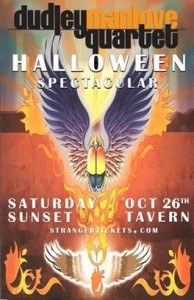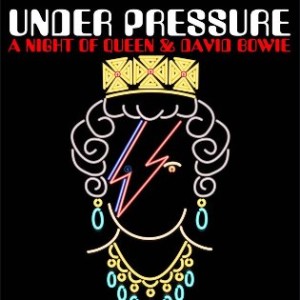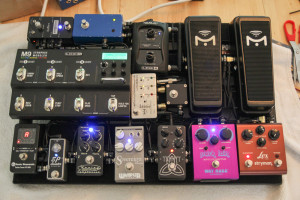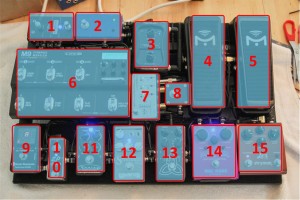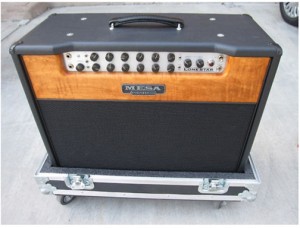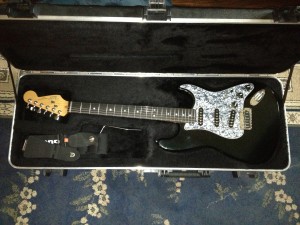
The Black Strat
We began our association over 20 years ago when I found it hanging on the wall of a local used guitar store. This is a late 80’s production model “Strat Ultra” with an ebony fretboard, staggered locking Sperzel tuners, 2-point fulcrum tremolo, and Wilkinsen roller nut. It’s also not entirely black… if you ever see this guitar in bright stage lighting you’ll notice it’s actually black with a pearl green clearcoat. According to my contact at Fender, there are a number of aspects about this guitar that are non-standard for the model, which suggests it was probably assembled in the “Fender custom shop” as a one-off customer order.
I knew this guitar was unusually good when I first picked it up. At that point it already had some fret wear and few dings and scratches. I immediately bonded with it and purchased it on the spot. The only significant change I made to this instrument was replacing the original electronics / pickguard. It had Fender “lace sensors” on it, with a humbucker in the bridge position. The replacement pickguard is the same black pearl finish, but is outfitted with Fralin blues pickups with a bass plate under the bridge.
Over the past 20+ years I’ve played this guitar for thousands of performances. We’ve had many adventures and covered a lot of miles together… it’s been my primary guitar for live shows, recordings, practicing, touring and teaching. I would estimate I’ve played at least ten thousand hours on this guitar! That’s a lot of wear on an instrument and on a lesser-quality guitar that toll can be irreparable. Earlier this year I finally had to accept the fact that the frets were very worn, the bridge saddle set screws were a mess, the string spacing was incorrect, and the sum result was a guitar with so many high-mileage idiosyncrasies that I was the only person capable of playing it. It was time for this guitar to see a doctor for significant work.
The only person I was willing to entrust this guitar to is Mike Lull. If you live in the Pacific Northwest, you know who he is. He’s not cheap, but as my friend Kris Geren says about guitar repair, “if you love it, send it to Lull”. Mike has worked on other guitars for me, including my strats, teles, and even my Warr Guitar.
The first thing Mike said upon looking at this guitar was that it should have been refretted a while ago. See? I told you nobody else could play it 🙂 He was right. The frets were very worn and rutted, and pretty uneven. We discussed options and I played several guitars in his shop to select the gauge and material for the new frets. Fortunately, the ebony fretboard was in very good condition and only minor resurfacing was needed. I gave Mike a list of additional work to do (see below) and we shook on it. Handing off my primary guitar for triple-bypass surgery gave me a few jitters, but I knew it was in good hands.
Two weeks later I picked up my reborn instrument. Here is the rundown on what was done:
- Refret with medium-jumbo stainless steel frets
- Plek treatment
- Replacement of rusty / corroded pickguard screws with stainless steel screws
- Grinding of the height-adjustment hex screws for the bridge saddles
- Complete setup
The instrument is MUCH different than before. Focusing on the most obvious (and expensive) element, it has new frets. The stainless steel frets are beautiful, shiny and smooth. They’re perfectly crowned and tuned. They’ll last forever and never corrode. Mike tightened up the neck/body connection and completely set up the instrument.
I haven’t played a show with it yet, but my initial reactions are
- WOW. This guitar is beautiful. The entire instrument just goes together so beautifully and plays so sweetly.
- It resonates and sustains like a boutique guitar should. It vibrates freely and evenly all along the entire neck.
- There is a newfound clarity in chords, especially in that tricky area in the first five frets. Fender guitars are notoriously out of tune between the third and seventh frets. This is a topic for a much longer blog post, but on the black strat the frets have been Plek’d , which has largely eliminated those issues.
This guitar was nowhere near this good when it rolled off the bench brand new. It has always been a fine instrument, but with this work completed it has become exceptionally great. This kind of transformation isn’t cheap… the shop bill for this work totaled more than I paid for the guitar! I have a few other guitars (ahem), and several of them were significantly more expensive than this one. Even my super-boutique-y Eric Johnson signature strat is relegated to backup status at gigs. That’s how special this black strat is to me. Having it achieve such a state of near-perfection is a beautiful thing.

